Overview
- Brief Narrative
- Small leather bag brought with the Bieder family, Isador and Fanny, and their daughters Gertrude, 10, and Frieda, 14, who were forced to leave Vienna, Austria, in 1939. After the annexation of Austria by Nazi Germany in March 1938, anti-Jewish laws were passed and Jews were targeted for persecution. Germans raided the family’s apartment, taking most of their valuables. A short while later, Isidor’s retail business was confiscated. During Kristallnacht on November 9-10, 1938, Isidor was arrested and beaten. As a condition of his release from prison, he agreed to leave Austria with his family. They received their exit permits on January 16, 1939, and left for Haifa, Palestine. After nearly a year, they sailed from there to Greece, then to America. Many extended family members in Gorlice, Poland, perished during the Holocaust.
- Date
-
emigration:
1939
- Geography
-
received:
Vienna (Austria)
- Credit Line
- United States Holocaust Memorial Museum Collection, Gift of Gertrude Bieder Meisner and the Estate of Gertrude Bieder Meisner
- Markings
- front flap, stamped, gold ink : PHONIX
- Contributor
-
Subject:
Gertrude Meisner
- Biography
-
Gertrude Bieder was born on January 23, 1929, in Vienna, Austria, to Isidor (Cham Isak) and Fanny (Feiga) Wilde Bieder. Both of her parents were born to Jewish families in Golwice, Poland: Isidor in 1894 and Fanny in 1904. The couple married in Vienna, Austria, on July 6, 1924, where Isidor owned a successful retail business. Gertrude had an older sister, Frieda, who was born on September 11, 1925. When Nazi Germany annexed Austria on March 13, 1938, Germans looted the family’s apartment and took their money, car, and other possessions. Anti-Jewish laws were passed and soon Isidor’s business was confiscated. During Kristallnacht on November 10, Isidor was arrested and severely beaten. Fanny was forced to scrub the streets. The family's apartment was sealed and they never returned there. Isidor was released with the condition that he and his family soon leave Austria.
The family received a permit to leave Vienna on January 16, 1939, after Isidor paid an expensive Jewish emigration tax. They travelled to Genoa, Italy, where they boarded the SS Esperia, arriving in Haifa, Palestine, on January 26. They lived in a room in a Jewish refugee resettlement center for several weeks; for the remaining months, they moved around the city. On November 20, 1939, the family sailed on the SS Andreas-Dorus for Piraeus, Greece. They transferred to the TSS Neas-Hellas and arrived in New York City on December 18. The family settled in Cleveland, Ohio. Gertrude married David Meisner and had two children. Her father passed away, age 83, in 1971. Her mother died, age 71, in 1975. Gertrude passed away, age 83, on February 26, 2012.
Physical Details
- Classification
-
Dress Accessories
- Category
-
Carried dress accessories
- Object Type
-
Pouches (Containers) (lcsh)
- Physical Description
- Leather pouch with a front flap and cloth lining.
- Dimensions
- overall: Height: 6.000 inches (15.24 cm) | Width: 9.500 inches (24.13 cm)
- Materials
- overall : leather, cloth, ink
Rights & Restrictions
- Conditions on Access
- No restrictions on access
- Conditions on Use
- No restrictions on use
Keywords & Subjects
- Topical Term
- Holocaust, Jewish (1939-1945)--Austria--Vienna--Personal narratives. Jewish families--Austria--Vienna--Biography. Jewish refugees--Palestine--Biography. Jewish refugees--United States--Biography. Jews--Persecutions--Austria--Vienna--Biography. Refugee children--Biography. World War, 1939-1945--Refugees--United States--Personal narratives.
Administrative Notes
- Legal Status
- Permanent Collection
- Provenance
- The leather pouch was donated to the United States Holocaust Memorial Museum in 2016 by Ben Meisner, grandson of Gertrude Meisner, on behalf of the Estate of Gertrude Bieder Meisner.
- Funding Note
- The cataloging of this artifact has been supported by a grant from the Conference on Jewish Material Claims Against Germany.
- Record last modified:
- 2024-10-03 13:05:12
- This page:
- https://collections.ushmm.org/search/catalog/irn551451
Download & Licensing
In-Person Research
- By Appointment
- Request 21 Days in Advance of Visit
- Plan a Research Visit
- Request to See This Object
Contact Us
Also in Isidor and Fanny Bieder collection
The collection consists of boots, a dress, gloves, jacket, necktie, two purses, shoes, and a wardrobe trunk, documents, and photographs relating to the experiences of Isidor and Fanny Bieder and their daughters, Frieda and Gertrude, in Vienna, Austria, and during their emigration to the United States via Palestine before and during the Holocaust.
Date: 1930-1939
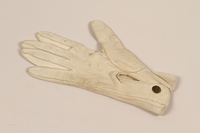
Pair of men's white leather driving gloves carried by a Jewish refugee during his escape from Vienna
Object
Gloves owned by Isidor Bieder who was forced to leave Vienna, Austria, with his wife, Fanny, and their two daughters, 14 year old Frieda, and 10 year old Gertrude, in January 1939. After the annexation of Austria by Nazi Germany in March 1938, anti-Jewish laws were passed and Jews were targeted for persecution. Germans raided the family’s apartment, taking most of their valuables, and a little later, Isidor’s business was confiscated. During the November Kristallnacht pogrom, Isidor was arrested and beaten. As a condition of Isidor’s release from prison, he agreed to leave Austria with his family. They received their exit permits on January 16, 1939, and left for Haifa, Palestine. After nearly a year, they sailed from there to Greece, then to the United States, and arrived in New York City on December 18.
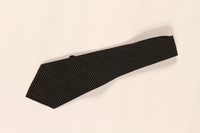
Black patterned silk necktie owned by a Jewish refugee
Object
Necktie owned by Isidor Bieder who was forced to leave Vienna, Austria, with his wife, Fanny, and their two daughters, 14 year old Frieda, and 10 year old Gertrude, in January 1939. After the annexation of Austria by Nazi Germany in March 1938, anti-Jewish laws were passed and Jews were targeted for persecution. Germans raided the family’s apartment, taking most of their valuables, and a little later, Isidor’s business was confiscated. During the November Kristallnacht pogrom, Isidor was arrested and beaten. As a condition of Isidor’s release from prison, he agreed to leave Austria with his family. They received their exit permits on January 16, 1939, and left for Haifa, Palestine. After nearly a year, they sailed from there to Greece, then to the United States, and arrived in New York City on December 18.
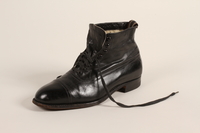
Pair of men's black leather lace-up ankle boots owned by a Jewish refugee during his escape from Vienna
Object
Boots owned by Isidor Bieder who was forced to leave Vienna, Austria, with his wife, Fanny, and their two daughters, 14 year old Frieda, and 10 year old Gertrude, in January 1939. After the annexation of Austria by Nazi Germany in March 1938, anti-Jewish laws were passed and Jews were targeted for persecution. Germans raided the family’s apartment, taking most of their valuables, and a little later, Isidor’s business was confiscated. During the November Kristallnacht pogrom, Isidor was arrested and beaten. As a condition of Isidor’s release from prison, he agreed to leave Austria with his family. They received their exit permits on January 16, 1939, and left for Haifa, Palestine. After nearly a year, they sailed from there to Greece, then to the United States, and arrived in New York City on December 18.
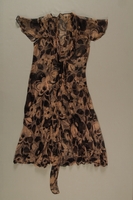
Pink and black floral patterned chiffon dress owned by a Jewish refugee from Austria
Object
Dress owned by Fanny Bieder who was forced to leave Vienna, Austria, with her husband, Isidor, and their two daughters, 14 year old Frieda and 10 year old Gertrude, in 1939. After the annexation of Austria by Nazi Germany in March 1938, anti-Jewish laws were passed and Jews were targeted for persecution. Germans raided the family’s apartment, taking most of their valuables, and a little later, Isidor’s business was confiscated. During the November Kristallnacht pogrom, Isidor was arrested and beaten. As a condition of Isidor’s release from prison, he agreed to leave Austria with his family. They received their exit permits on January 16, 1939, and left for Haifa, Palestine. After nearly a year, they sailed from there to Greece, then to the United States, and arrived in New York City on December 18.
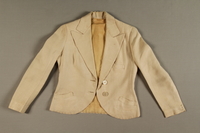
Woman’s white cloth tailored jacket owned by a Jewish refugee during her escape from Vienna
Object
Jacket owned by Fanny Bieder who was forced to leave Vienna, Austria, with her husband, Isidor, and their two daughters, 14 year old Frieda and 10 year old Gertrude, in 1939. She acquired the jacket for her 1933 cruise to Italy and Palestine with her husband. After the annexation of Austria by Nazi Germany in March 1938, anti-Jewish laws were passed and Jews were targeted for persecution. Germans raided the family’s apartment, taking most of their valuables, and a little later, Isidor’s business was confiscated. During the November Kristallnacht pogrom, Isidor was arrested and beaten. As a condition of Isidor’s release from prison, he agreed to leave Austria with his family. They received their exit permits on January 16, 1939, and left for Haifa, Palestine. After nearly a year, they sailed from there to Greece, then to the United States, and arrived in New York City on December 18.
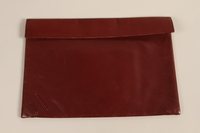
Red leather purse with decorative lacing carried by a Jewish refugee during her escape from Vienna
Object
Purse owned by Fanny Bieder who was forced to leave Vienna, Austria, with her husband, Isidor, and their two daughters, 14 year old Frieda and 10 year old Gertrude, in 1939. After the annexation of Austria by Nazi Germany in March 1938, anti-Jewish laws were passed and Jews were targeted for persecution. Germans raided the family’s apartment, taking most of their valuables, and a little later, Isidor’s business was confiscated. During the November Kristallnacht pogrom, Isidor was arrested and beaten. As a condition of Isidor’s release from prison, he agreed to leave Austria with his family. They received their exit permits on January 16, 1939, and left for Haifa, Palestine. After nearly a year, they sailed from there to Greece, then to the United States, and arrived in New York City on December 18.
Isidor and Fanny Bieder papers
Document
The papers consist of six photographs and documents relating to the experiences of the Bieder family in Vienna, Austria, before World War II and their flight from Austria to the United States via Palestine and Greece in 1939. The documents include two land deeds issued to Isidor Bieder for property purchased in Haifa, Palestine, in 1933, a "Reichsfluchtsteuerbescheid" issued for monies paid by Isidor Bieder to leave Vienna, a document stating that the Bieder family were citizens of Vienna, two documents listing property confiscated from the Bieder family, and a permit for the Bieder family to leave Vienna.
Upright domed traveling wardrobe trunk used by an Austrian Jewish family
Object
Trunk used by Fanny and Isidor Bieder and their daughters, 14 year old Frieda and 10 year old Gertrude, when they were forced to leave Vienna, Austria in January 1939. They shipped it to Haifa, Palestine, from Vienna in 1939 and used it when they eventually emigrated to the United States. It was purchased by them in 1933 for a cruise to Italy and Haifa, Palestine. After the annexation of Austria by Nazi Germany in March 1938, anti-Jewish laws were passed and Jews were targeted for persecution. Germans raided the family’s apartment, taking most of their valuables, and a little later, Isidor’s business was confiscated. During the November Kristallnacht pogrom, Isidor was arrested and beaten. As a condition of Isidor’s release from prison, he agreed to leave Austria with his family. They received their exit permits on January 16, 1939, and left for Haifa. After nearly a year, they sailed from there to Greece, then the United States, and arrived in New York City on December 18, 1939.



